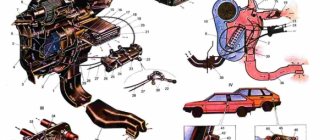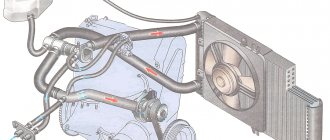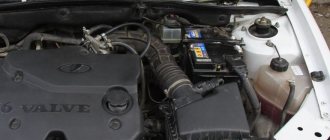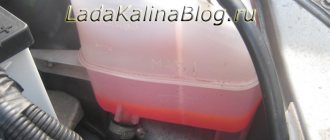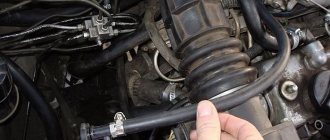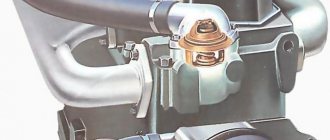Elimination of air locks in the cooling system on VAZ 2101-VAZ 2107
Welcome! Air locks in the cooling system - they usually occur when replacing coolant in a car engine, as well as when replacing individual components of the cooling system and when replacing hoses.
If an air lock has formed in your car, then it is recommended to eliminate it because it can cause the engine to overheat. Note! You may need a small slide to clear the air lock!
Summary:
How can you tell if there is an air lock in the cooling system? This is very easy to do, but only if your stove radiator is in working condition. To check, start the engine of your car and let it warm up to operating temperature, and after warming up, turn on the heater and use your hand to determine what kind of air is coming out of it.
Note! If the air is warm, then there are no plugs in the system, and if the air is cold, then there are plugs in the cooling system and they need to be removed!
How to bleed air using the VAZ model range as an example
VAZ models have a design advantage in the arrangement of cooling system components - a convenient position of the cooled throttle assembly (carburetor), which is the highest place in the cooling system. The procedure for a Lada Kalina car is as follows (the only tool you need is a Phillips screwdriver).
Fully open the heater switch (to the highest temperature);
Remove the valve cover protective screen;
Disconnected heating outlet hose from the throttle fitting
Remove the cap from the expansion tank
Video: How to remove air from the expansion tank
The second method of releasing air differs from the first only in that you do not need to force air masses into the neck of the expansion tank with your mouth. All operations are performed with the engine normally warmed up and turned off. This method does not involve any manipulations with the expansion tank cap. Immediately remove one of the two heating hoses from the throttle fittings. If coolant leaks, the hose is inserted into place and tightened. It may not work out the first time, then the operation must be done again. This method requires care and caution, since the antifreeze is heated to a temperature of 90 degrees and is under increased pressure.
The third method does not require any disassembly of the cooling system. True, its effectiveness is not very high. The car drives its front wheels onto an embankment so that the radiator cap becomes the highest point in the cooling system. The radiator and expansion tank caps are removed. The engine starts, the antifreeze temperature is brought to operating parameters. When reducing the volume of coolant, it must be constantly added to the amount recommended by the manufacturer. It is necessary to expel the air lock until bubbles stop coming out of the neck of the radiator or expansion tank.
How to eliminate air locks in the cooling system?
Method 1: First, open the hood of the car, and then with your hand press three times on the outlet (Indicated by a red arrow), bypass (Indicated by a green arrow) and inlet (Indicated in the photo by a blue arrow) radiator hoses.
Note! Press all hoses only with your hands; under no circumstances use pliers or anything else for this, because this can lead to deformation of the hoses!
Method 2: This method came from the people, it doesn’t always work, but it’s still worth a try:
Find a small slope or overpass, drive the car onto it so that the front part is higher than the rear and then let the engine idle for “5 minutes” and the traffic jam should disappear.
Note! Always remember one important thing, after you try one of the methods, immediately check whether the plug has been eliminated by warming up the engine to operating temperature, and after warming up by turning on the heater - if the air from the heater is warm, then the plug is missing!
Share! If you know a few more ways to eliminate blockages in the cooling system, then describe them in the comments and people will appreciate it!
Additional video: For more information on how to understand when a plug has appeared in the cooling system and how to eliminate it, see the video below:
Source
How to remove an air lock in a VAZ 2107 injector
During the operation of a VAZ 2107 car, it is necessary to carry out not only repairs of failed parts, but also preventive measures. One of these measures is replacing the coolant in the system. However, often after replacing the coolant, air pockets appear in the system. That is why the relevant question is how to remove air from the VAZ 2107 cooling system in order to prevent the engine from overheating and failing.
How to prevent the problem from recurring
At least there is a guarantee for the car service work.
The surest way to avoid unnecessary problems with your car is to trust the service to professionals. The structure of a car and an engine in particular is constantly becoming more complex. A modern cooling system consists of many irregularly shaped parts, tubes and hoses located at different angles. In a word, there are many places where air can accumulate in the cooling system. Professionals know all the intricacies of filling the antifreeze system and can easily replace the old fluid with a new one.
Engine overheating can be prevented with regular maintenance
There is no need to allow the engine to overheat, bring the antifreeze to a boil. At this moment, the coolant turns into steam, which, under high pressure (the system is closed) fills all the most inaccessible corners of the cooling system. In this case, the engine itself is at great risk of serious damage. It also takes a lot of skill and experience to remove air from your car's cooling system.
If you do not remove the air lock from the cooling system in time, there is a chance that the engine will incur significant costs for repair and restoration. So the question “how to remove air from the cooling system” must be taken seriously.
Signs of air in the cooling system
The presence of an air lock in the engine cooling system causes serious consequences, including overheating of the engine and its failure. The presence of a plug will immediately manifest itself in the form of uneven heating of the engine. The air in the system restricts the passage of coolant in a large or small circle. The fact that the plug is present helps reduce the heat exchange between the engine and the antifreeze, so there will be an increase in temperature above the maximum level, which is unacceptable.
The plug can also prevent the passage of fluid to the heater core, so driving the car in winter will be cold. Heated antifreeze does not pass to the heater radiator through the cooling system of the VAZ 2107, so when it is turned on, a stream of cold air will blow into the cabin.
It is contraindicated to operate the machine in this condition until air has been removed from the system. To remove it, several different methods are known, which are described in detail in the material.
Reasons for the formation of air pockets
The formation of a plug in the cooling system is also called airing. This phenomenon occurs in the pipes and hoses, whereby their throughput capacity is lost, thereby causing overheating of the engine and boiling of the coolant. Before you remove the plug from the system, you will need to understand the reasons for its occurrence.
It is necessary to identify the causes of airing in order to prevent its reoccurrence. So, let's look at the reasons for airing the cooling system of the VAZ 2107 injector:
After identifying and eliminating the causes, you can begin drastic actions to eliminate air pollution on the VAZ 2107.
Stopper removal methods
To remove the plug, or rather to prevent its occurrence, you need to do the following simple steps while pouring coolant:
After pouring antifreeze, you need to start the engine and repeat the procedure of pushing through the pipes, which will prevent the formation of air. Even if a plug has formed, follow the same procedure to try to remove air from the system. This is the first method, which is the simplest and least expensive.
The second way to remove an air lock from the cooling system involves using a slope, which you need to drive the front of the car onto. This technique is simple, and to implement it you need to warm up the engine at idle for at least 10-15 minutes. In this case, the air should leave the system on its own, but be sure to note the time so that the engine has time to warm up to operating temperature, thereby opening a large circulation circle.
This is interesting! You can make sure that airing has disappeared by checking - if the engine reaches operating temperature and does not overheat, and warm or hot air is blowing from the stove, then the problem has been successfully resolved.
The removal of the plug can also be determined by a decrease in the coolant level in the expansion tank. If the level has dropped, it means that the procedure was completed successfully, and all that remains is to add antifreeze or antifreeze to the mark.
Squeezing out the air plug
If air has formed in the stove, then the plug can be removed in a more effective way. This method is more difficult to implement than those listed above, but it is 100% guaranteed to help remove air from the stove. The instructions for squeezing air out of the VAZ 2107 cooling system are as follows:
If adding antifreeze does not lead to a positive result, then proceed to another method. Its essence is to perform the following actions:
How to ventilate the VAZ-2106 stove
The interior heating system on your “six” is functioning properly, but warm air does not flow in even when the engine is well warmed up? It is likely that you are faced with a standard situation when the VAZ 2106 stove is airy. It is necessary to understand that the presence of air in the heater system, which, in fact, is a branch of the engine cooling system, is fraught not only with a cold car interior. The fact is that air bubbles impede the movement of coolant, resulting in a risk of engine overheating with all the ensuing consequences. Therefore, it is better not to operate the car in this condition and immediately take measures to remove the air lock.
Domestic motorists use various methods to ventilate the radiator of the heating system. Some are quite effective, but with others you have to rely on your own luck. If, nevertheless, the stove on your VAZ-2106 blows, we can recommend only two effective ways to solve this problem. Moreover, the first method is “folk” and the simplest, therefore it is very popular, and the second method is recommended by professionals.
We expel air from the interior heater radiator - method one
The implementation of this method involves installing the car on a slope. That is, in order to ventilate the VAZ-2106 stove, you need to find an area with suitable relief or drive the car onto an overpass in such a way as to raise its front part. Now you need to start the engine and let it run for 5-10 minutes at idle speed. This way you can remove the blockage from the system quickly and with minimal effort.
With all this, it should be noted that the use of this method does not provide a 100% guarantee of obtaining the expected result. Therefore, if you decide to expel air with its help, consider what has been said. If you do not want to rely on luck and intend to act for sure, then the method described below will be the optimal solution.
Removing the air lock from the interior heater radiator - method two
The essence of this method is to expel air from the VAZ-2106 stove through the hole at its highest point. The role of such a hole is a tube through which antifreeze from the heater radiator returns to the cooling system. The order of necessary actions is given below:
- First you need to loosen the clamp on the pipe connecting the upper radiator tube of the heater to the cooling system.
- Next, without removing the pipe, fill the expansion tank with pre-prepared coolant.
- After this, remove the pipe and put it back on, but not completely - so that it only rests on the edge of the tube.
- Now start the engine and let it warm up to a temperature of 80-85 degrees.
- With the engine running, begin to remove the top part of the pipe slightly from the tube. Keep it in this position until the air is removed from the heating system. You will know about this when antifreeze comes out of the tube and the pipe begins to heat up.
Important! Before carrying out the operation to remove the air lock, it is better to wear gloves to avoid the unpleasant consequences of contact with a hot hose or accidentally spilled antifreeze.
The described method is considered one of the most effective. Its use allows you to quickly de-air the heating system. But regardless of how you removed air from the stove, upon completion of the work done, you must check whether the desired result was achieved. To do this, the car engine warms up to operating temperature and the heater turns on. If warm air enters the cabin, it means your actions were successful.
Causes of air locks
Air in the cooling system can be caused by a number of malfunctions. Among them:
- Depressurization of the system . It can occur in a variety of places - on hoses, fittings, pipes, pipes, and so on. Depressurization can be caused by mechanical damage to its individual parts, their natural wear, or a decrease in pressure in the system. If, after you have removed the air lock, air appears in the system again, it means that it is depressurized. Therefore, it is necessary to do diagnostics and visual inspection in order to identify the damaged area.
You need to pour antifreeze in a thin stream.
Each of the reasons described above can damage the components and mechanisms of the car. First of all the engine suffers because its normal cooling is disrupted. It overheats, causing wear to become critical. And this can lead to deformation of its individual parts, failure of sealing elements, and in especially dangerous cases, even to jamming.
Airing also leads to poor stove performance. The reasons for this are similar. Antifreeze does not circulate well and does not tolerate sufficient heat.
Next, let's move directly to the methods by which you can remove the air lock from the cooling system. They differ in the method of execution, as well as complexity.
How to determine if there is a problem: symptoms, signs, diagnosis
Diagnostics are designed to help find the cause of malfunctioning cooling system. If antifreeze constantly disappears somewhere, boils, boils strongly in the cooling radiator, and the interior does not heat up, all this needs to be dealt with. If the antifreeze level regularly drops, air will take its place, which over time will form an air lock. In this case, you need to check the tightness of all connections of the engine cooling system. To do this, carry out a careful external inspection of the interfaces of rubber parts (hoses, pipes) with tubes and fittings with a warm, running engine. Pay special attention to the radiator pipes, water pump, thermostat and heater hoses. If a leak is detected, it must be eliminated by replacing the pipes or tightening the steel clamps.
Methods for removing air lock from the cooling system
How to remove an air lock from the cooling system of a VAZ classic
There are three main methods by which you can eliminate an air lock. Let's list them in order. The first method is great for VAZ cars . Its algorithm will be as follows:
The second method is carried out in accordance with the following algorithm:
The third method of how to remove an air lock from the system must be done as follows:
As for the last method, on machines with an automatically turned on cooling system fan, you don’t even have to over-gas, but calmly let the engine warm up and wait until the fan turns on. At the same time, the movement of the coolant will increase, and under the influence of circulation, air will leave the system. In this case, it is important to add coolant to the system in order to prevent airing again.
General recommendations for prevention
The first thing you need to pay attention to is the level of antifreeze in the cooling system . Always monitor it and top up if necessary. Moreover, if you have to add coolant very often, then this is the first call indicating that something is wrong with the system, and additional diagnostics are necessary to identify the cause of the malfunction. Also check for stains from antifreeze leaks. It is better to do this in the inspection hole.
Try to use the antifreeze recommended by your car manufacturer. Make purchases in trusted, licensed stores, minimizing the likelihood of purchasing a counterfeit. The fact is that low-quality coolant can gradually evaporate during repeated heating, and instead of it, an air plug forms in the system. Therefore, do not neglect the manufacturer's requirements.
Instead of a conclusion
Finally, I would like to note that if the described signs of airing in the system appear, it is necessary to carry out diagnostics and check it as quickly as possible. After all, an air lock significantly reduces the efficiency of the cooling system. Because of this, the engine operates under conditions of increased wear, which can lead to premature failure. Therefore, if you detect airing, try to get rid of the plug as quickly as possible. Fortunately, even a novice car enthusiast can do this, since the procedure is simple and does not require the use of additional tools or devices.
Source
Reasons for air getting into the VAZ cooling system
The most common cause of air getting into the cooling system is leaky connections. Depressurization of connections, in turn, can occur due to the negligence of the car owner himself. Timely diagnosis and replacement of old gaskets significantly reduce the risk of air entering the system through this route. First of all, we are talking about cylinder head gaskets and pumps.
The top most common reasons for the formation of an air lock is also a complete or partial replacement of the coolant. Therefore, after such an operation, it is imperative to make sure that no air has entered the system.
And finally, the third most common reason for the formation of an air lock is considered to be a problem with the air valve located in the expansion tank. Due to wear or malfunction, the valve may “stick”, resulting in a plug.
Whatever the reason for the appearance of an air lock, it should be eliminated as an emergency. Otherwise, you risk getting into at least a major engine overhaul, or even into a much more unpleasant situation of a traffic accident.
Articles
- 21110-1008650-00 – plastic screen (only for 11183);
- 21120-1008658-00 – rubber screen pin;
- 21080-1311065-00 (-01, -03) – expansion tank plug;
- 21080-1311067-00 – gasket for the plug.
Do you only need distillate?
We tried to expel air from the system, but on the VAZ-2114 the entire “plug” takes up 100-150 ml. This means you don’t have to add anything at all to the tank. You can also add regular distilled water.
It is easier to find a 100 ml package of distillate at a pharmacy or battery store.
Causes of air accumulation in antifreeze
Closed liquid cooling systems are designed to maintain constant excess pressure (up to 100 kPa). The increased pressure made it possible to raise the boiling point of the liquid to 120 degrees. Since cars are used all year round, a concentrated, special non-freezing coolant was specially developed for them - antifreeze (antifreeze is the most popular). It consists of ethylene glycol, distilled water and anti-corrosion, anti-foaming, antioxidant additives. Antifreeze provides optimal thermal operating conditions for the engine of 80–100 degrees in any weather. The main causes of air locks are as follows:
Video: How not to air out the cooling system when filling with antifreeze
Checking the hoses
The second way to expel air from the VAZ-2107 stove is to find the hoses from the cooler under the hood and move them. It is quite possible that such a mechanical effect will provoke the release of an air bubble.
After the completed manipulations, check the operation of the heater. If warm air comes out, then the problem is solved. If everything remains as it was, it’s time to try the next method of airing.
Step-by-step instruction
The next method of how to blow out the stove on a VAZ-2107 will be discussed step by step. So:
- Unscrew and pull out the top pipe. This pipe goes directly to the stove, and this is the highest point where air can accumulate.
- We insert the pipe into place without twisting it.
- Fill the antifreeze tank full. It’s better to play it safe and pour antifreeze through a cloth to prevent debris from getting into the heating system. This is a rather tedious and time-consuming process, but it is necessary so as not to damage the system.
- We start the engine and bring it to 80 degrees. Now you need to let the air out through the highest pipe.
- To do this, we take it a little and move it.
- We carry out this procedure until the antifreeze flows out. If the antifreeze has poured out, it means that almost all the air has already escaped.
- If a small air bubble remains, it will then come out through the expansion tank.
This is one of the most effective ways to blow out the stove on a VAZ-2107. With the help of these instructions you will cope with this problem and be sure to restore the operation of the stove!
https://www.youtube.com/watch?v=IUxSR1QLvco
Reasons why air appears in the cooling system
Air appears in the system due to malfunctions, actions or inactions on the part of the driver. The following reasons are identified:
If coolant gets into the engine crankcase, it is easy to check with the oil level dipstick; the level will be higher than expected. If water is used as coolant, the engine oil will turn white. Sometimes air gets into the brake system, in which case the system also needs to bleed air. And for this you need to know the diagram, which wheel to start with and what exactly to do to bleed brakes with ABS and how to bleed brakes without ABS. If the entire fuel fluid has leaked or you want to replace it, then such work also has its own nuances. In particular, you need to know which brake fluids can be mixed and how much brake fluid is needed for replacement.
Reasons for airing
The air that has penetrated into the system is collected into one bubble, moving through the channels to a certain place. Having reached the highest point or narrowing, it stops and blocks the flow of antifreeze (antifreeze). Practice shows that most often an air lock occurs in a large circulation circuit, including the main radiator. Although the opposite situation also happens, for example, airing of the heat exchanger of the cabin heater (in common parlance - the stove).
How air enters the cooling system of a car engine:
The main task solved during the process of filling antifreeze is to simultaneously expel air from the cooling system. If you perform the operation in a hurry and do not follow simple rules, the formation of an air lock is guaranteed. Quick filling allows air to enter the system along with the liquid through the funnel, and then collect into one bubble.
Important point! An obvious sign of airing is a critical rise in coolant temperature at any engine operating mode.
The inclusion of an electric fan depends on the make and model of the car: if the temperature sensor is in the cylinder head, forced airflow will definitely work.
If the meter is located differently (in the main radiator, on the pipe), the fan may not start due to the sensor being in a stagnant zone. How will air get through leaks in a pressurized system, you ask? The algorithm is simple:
Similarly, airing of the cooling system occurs due to the jamming of the bypass valve. Cooling and shrinking antifreeze provokes the formation of a vacuum, which is not replenished by air flow from the outside. Then suction occurs in the weakest connections.
Device
The first place where the fluid begins its flow is the radiator. On VAZ 2106 models, two types of radiators were installed - copper and aluminum. The first one is of higher quality, and if cracks appear on its surface, they can easily be welded. In contrast, any crack on an aluminum part is its certain death.
The radiator figuratively consists of three parts: the upper barrel, the cooling honeycomb and the lower barrel. The upper tank has a filler neck for adding coolant. During operation, hot liquid that has gone through one cycle is collected in this tank. Further, it descends into the lower barrel, through the honeycombs, simultaneously being cooled by a fan. And in the lower tank, the liquid is already completely cooled and ready for use.
Tubes are connected to the radiator from above and below: two wide and one narrow. A narrow tube connects the radiator to an expansion barrel, designed to allow excess liquid to enter it during heating and expansion. The upper wide tube connects the part to the thermostat, which, in turn, uses a valve to regulate the flow of coolant. Fluid can flow from the thermostat either back to the engine cylinder block or to the radiator.
For forced circulation, the system includes a pump that pumps antifreeze, creating pressure inside the block. Between the cylinders, a specially made void is provided, where this liquid enters.
Signs of air in the cooling system
The presence of an air lock in the engine cooling system causes serious consequences, including overheating of the engine and its failure. The presence of a plug will immediately manifest itself in the form of uneven heating of the engine. The air in the system restricts the passage of coolant in a large or small circle. The fact that the plug is present helps reduce the heat exchange between the engine and the antifreeze, so there will be an increase in temperature above the maximum level, which is unacceptable.
The plug can also prevent the passage of fluid to the heater core, so driving the car in winter will be cold. Heated antifreeze does not pass to the heater radiator through the cooling system of the VAZ 2107, so when it is turned on, a stream of cold air will blow into the cabin.
Causes and symptoms of malfunction
The appearance of air jams is a common problem for experienced car enthusiasts, which they often encounter. But before you remove air from the cooling system, it is still advisable to know the cause of the malfunction.
There are several of them:
- Errors when adding coolant or replacing it.
- Suction at the junction of pipes.
Similar problems in 90% of cases occur in winter, when the fittings decrease in size under the influence of low temperatures.
As a result, microcracks or other types of damage appear, through which excess air leaks;
- Atmospheric valve defect;
- pump depressurization;
- the appearance of leaks in radiators (cooling or heating);
- damage to the gasket under the cylinder head (white smoke appears from the exhaust pipe, oil leakage from under the cylinder head becomes noticeable);
- thermostat failure;
- mechanical defects or clogging of radiators (pipes connecting them).
The presence of an air lock in the cooling system can be easily diagnosed; the engine takes a long time to warm up or, conversely, does not reach the required temperature at all.
It's easy to explain. Due to strong airiness, antifreeze (antifreeze) cannot normally enter the cooling radiator. As a result, the engine temperature constantly increases.
The consequences can be catastrophic, especially in winter. The heater (stove) does not work. In this case, the coolant no longer enters the heater radiator and, as a result, it does not warm up.
In any of the above cases, it may be necessary to remove air from the cooling system. But how to do it right?
General recommendations for prevention
The first thing you need to pay attention to is the level of antifreeze in the cooling system . Always monitor it and top up if necessary. Moreover, if you have to add coolant very often, then this is the first call indicating that something is wrong with the system, and additional diagnostics are necessary to identify the cause of the malfunction. Also check for stains from antifreeze leaks. It is better to do this in the inspection hole.
Try to use the antifreeze recommended by your car manufacturer. Make purchases in trusted, licensed stores, minimizing the likelihood of purchasing a counterfeit. The fact is that low-quality coolant can gradually evaporate during repeated heating, and instead of it, an air plug forms in the system. Therefore, do not neglect the manufacturer's requirements.
